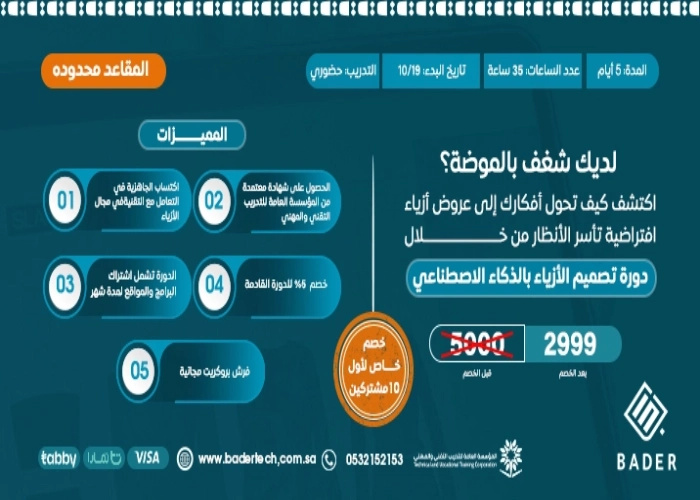Program Objective:
Developing participants' abilities to design training programs and prepare training manuals based on scientific principles.
Skills the Program Aims to Develop:
Enhancing participants' ability to design training programs and prepare training manuals according to scientific principles.
Objectives:
-
Elements of training program design.
-
Elements of training manual design.
-
Designing the training program.
-
Appropriate training methods.
-
Organizing the contents of the training manual.
Outcomes:
Upon completing the training program, the trainee is expected to be able to:
-
Identify the basic concepts of designing training programs and preparing training manuals.
-
Identify the elements of training program design.
-
Design a training program based on scientific principles and rules.
-
Identify appropriate training inputs when preparing manuals.
-
Use suitable training methods.
-
Organize the content of the training manual scientifically.
About course
Training program design is the process aimed at creating and developing effective training programs that meet the needs of individuals and organizations, helping improve performance and enhance skills. Designing training programs is one of the most important aspects of organizational development, as it directly contributes to improving employee efficiency and achieving the organization's strategic goals.
In this course, you will learn how to design training programs aimed at achieving specific objectives, with a focus on accurately identifying training needs, and clearly formulating training goals to ensure effective impact on trainees. We will also explore how to choose the appropriate training methods that align with the type of content and the trainees' audience.
You will also gain the necessary skills to design innovative training content that blends theory with practical application, along with how to organize an effective timetable to ensure training is delivered on time. Furthermore, you will learn the importance of evaluating the effectiveness of training programs and using feedback to improve future performance.
How to Formulate Training Objectives Clearly
Formulating training objectives clearly is one of the essential steps in designing effective training programs. Training objectives form the foundation upon which the training content is built, determining the path the program must follow to ensure tangible results. Accurately and clearly formulating objectives helps in defining the right direction for the training program and contributes to maximizing the benefit from available resources.
Importance of Formulating Training Objectives Clearly
Clear training objectives help guide trainees and human resources towards achieving specific results. They also provide a metric by which the success of the training program can be measured and its effectiveness assessed. Clear objectives contribute to increasing engagement with trainees and directing their focus toward the skills and knowledge they need to acquire.
Steps to Formulate Training Objectives Clearly:
-
Define the Targeted Skills or Knowledge:
The training objective should focus on the skills or knowledge the trainees must acquire. For example, the objective might be "Teach trainees how to use statistical analysis tools in their work." -
Use the SMART Formula:
To ensure clarity and effectiveness, it is preferred to use the SMART method (Specific, Measurable, Achievable, Relevant, Time-bound). For example, "Increase proficiency in using Excel by 20% within 3 months." -
Consider Trainee Needs:
The objectives must be linked to the actual needs of the trainees, whether these needs involve developing new skills or improving existing ones. The objective should be tangible and account for the trainee's initial level. -
Align with Organizational Goals:
The training objectives should align with the organization’s strategies and goals. For example, if the organizational goal is to improve productivity, the training objective might involve "Teaching employees how to improve time management." -
Use Clear, Actionable Words:
It is important to use precise and strong words when formulating objectives, such as "achieve," "improve," "learn," or "increase." These words help define the expected result more clearly.
Benefits of Clear Training Objectives:
-
They contribute to achieving tangible results, allowing organizations to measure success.
-
They help focus trainees on the most important tasks and skills.
-
They provide a means to evaluate trainee performance after the training program.
-
They contribute to improving training program efficiency through precise objective setting.
Clearly formulating training objectives is one of the key factors contributing to the success of training program design and ensuring that desired results are achieved. By setting accurate and tangible objectives, maximum benefit can be achieved from human resources and productivity can be increased within the organization.
Designing the Training Program Content
Designing the training program content is one of the most important elements of designing training programs that help improve trainees' efficiency and effectively enhance their skills. The training content is the foundation upon which trainees build their knowledge and skills, playing a major role in achieving the training objectives. Designing training content requires following systematic and precise steps to ensure that information is presented in an engaging and effective way.
Importance of Designing the Training Program Content
Designing training program content accurately requires a deep understanding of trainees' needs and the goals the program aims to achieve. By designing a comprehensive training content, organizations can ensure that trainees acquire the skills and knowledge that help them improve their job performance and achieve organizational objectives. The content must align with the latest training strategies and technological developments to ensure its effectiveness.
Steps to Design the Training Program Content:
-
Clearly Define the Training Objectives:
The objective of the training program should be clear and measurable. By defining the objectives, designers can ensure that the content aligns with the trainees' needs and the organization's requirements. The objectives must be related to actionable outcomes that can be applied in practical settings. -
Choose the Appropriate Topics and Resources:
Topics should be selected based on the training objectives and identified needs. These topics must be realistic and address the skills that need to be developed, with appropriate learning resources such as presentations, videos, and training books. -
Organize the Content Logically:
The training content should be arranged logically and cohesively. The program should start with basic concepts and progress to more complex topics. Each section of the program should have a clear training objective that links to the next section. -
Use Diverse Training Methods:
It is preferable to integrate different training methods into the program design, such as active learning, workshops, and e-learning. This helps increase engagement with trainees and encourages them to participate actively. -
Evaluate the Effectiveness of the Training Program:
Evaluation includes tools to assess whether the training objectives were achieved and how much trainees benefited. Feedback surveys, short tests, and trainee feedback can be used to determine if the content achieved the desired outcomes.
Bader Technology Center: Your Partner in Training Program Design
Bader Technology Center is one of the leading centers in training program design and offering accredited training courses in various fields. The center stands out for its focus on innovative training content that aligns with the latest developments in training program design. Bader Technology Center offers comprehensive and specialized training programs that combine theoretical content with practical application using advanced teaching methods.
The center also provides accredited certificates that enhance trainees' resumes, increasing their chances in the job market. Through designing high-quality training programs, Bader Technology Center contributes to improving skills and job capabilities for individuals within organizations.
The Best Course in Training Program Design
Designing training programs is a strategic process aimed at creating effective programs that meet the needs of individuals and organizations, helping improve performance and enhance skills. This process is one of the cornerstones that contribute to improving organizational performance and enhancing operational efficiency.
Bader Technology Center is one of the leading training centers in Saudi Arabia, offering specialized courses in training program design. The center focuses on providing participants with the knowledge and skills needed to implement effective strategies in workforce management.
Advantages of the Training Program Design Course at Bader Technology Center:
-
Internationally Accredited Certificates: Certificates awarded by Bader Technology Center are recognized by official bodies, enhancing participants’ professional value.
-
Comprehensive Training Content: The course covers various aspects such as needs analysis, forecasting future requirements, and developing recruitment strategies.
-
Professional Trainers: Bader Technology Center’s team consists of highly experienced trainers in human resource management.
-
Flexible Learning Options: The courses are available in both in-person and remote formats to meet the various needs of trainees.
-
Continuous Support: The center offers workshops and regular reviews to ensure the effective application of the knowledge acquired.
If you're looking to develop your skills in training program design and obtain an accredited certificate, Bader Technology Center is the ideal choice for you. Start your journey toward a brighter career future today.


































